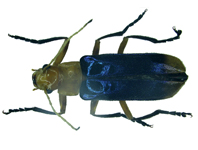Abstract
In oceanic islands, well age-constrained deposits containing arthropod somatofossils (body fossils) are rare. However, when available, these are important for providing empirical and independent minimum ages for molecular phylogenetic dating and complementary data on taxonomy, evolution and palaeobiogeography information of the biological groups found as fossils. This is especially important for taxa that speciated within oceanic islands, many becoming single island endemics (SIE). Recently, associated with a 1.3 Ma (Calabrian) fluvial and lacustrine sedimentary deposit from Porto da Cruz in Madeira Island (Fig. 1), a wing, putatively identified as Hymenoptera, was found. Here we describe this wing fossil as belonging to Ichneumonidae, a group with ca. 30% of SIE in Madeira Island. Moreover, this is the first somatofossil of ichneumonid parasitic wasps found in Madeira Island and in Macaronesian islands (i.e. Azores, Madeira, Canaries and Cabo Verde).
References
Aguiar, A.F., Cravo, D. & Gonçalves, Y. (2017) Sawflies and horntails of Madeira Archipelago (Hymenoptera: Symphyta), with the first records of two wasp species (Hymenoptera: Ibaliidae & Ichneumonidae) parasitizing Sirex noctilio (Fabricius, 1793). Entomologist’s Monthly Magazine, 153, 157–170.
Aguiar, A.M.F. (2008) List of arthropods (Arthropoda): Hymenoptera (Bethylidae, Dryinidae, Ichneumonidae). In: Borges, P.A.V., Abreu, C., Aguiar, A.M.F., Carvalho, P. Jardim, R., Melo, I., Oliveira, P., Sérgio, C., Serrano, A.R.M. & Vieira, P. (Coord.), Listagem dos fungos, flora e fauna terrestre dos arquipélagos da Madeira e Selvagens. Direcção Regional do Ambiente da Madeira e Universidade dos Açores, Funchal e Angra do Heroísmo, pp. 352–354.
Borges, P.A.V., Aguiar, A.M.F., Boieiro, M., Carles-Tolrá, M. & Serrano, A.R.M. (2008) The arthropods (Arthropoda) of the Madeira and Selvagens archipelagos. In: Borges, P.A.V., Abreu, C., Aguiar, A.M.F., Carvalho, P. Jardim, R., Melo, I., Oliveira, P., Sérgio, C., Serrano, A.R.M. & Vieira, P. (Coord.), Listagem dos fungos, flora e fauna terrestre dos arquipélagos da Madeira e Selvagens. Direcção Regional do Ambiente da Madeira e Universidade dos Açores, Funchal e Angra do Heroísmo, pp. 245–262
Broad, G. (2011) Identification key to the subfamilies of Ichneumonidae (Hymenoptera). The Natural History Museum, London, 40 pp.
Darwin, C. (1859) On the origin of species by means of natural selection, or the preservation of favoured races in the struggle for life. John Murray, London, 502 pp.
Edwards, N. & Meco, J. (2000) Morphology and palaeoenvironment of brood cells of Quaternary ground-nesting solitary bees (Hymenoptera, Apidae) from Fuerteventura, Canary Islands, Spain. Proceedings of the Geologists’ Association, 111, 173–183.
https://doi.org/10.1016/S0016-7878(00)80007-3
Fernández-Palacios, J.M., de Nascimento, L., Otto, R., Delgado, J.D., García-del-Rey, E., Arévalo, J.R. & Whittaker, R.J. (2011) A reconstruction of Palaeo-Macaronesia, with particular reference to the long-term biogeography of the Atlantic island laurel forests. Journal of Biogeography, 38, 226–246.
https://doi.org/10.1111/j.1365-2699.2010.02427.x
Góis-Marques, C.A., Madeira, J. & Menezes de Sequeira, M. (2018) Inventory and review of the Mio-Pleistocene São Jorge flora (Madeira Island, Portugal): palaeoecological and biogeographical implications. Journal of Systematic Palaeontology, 16, 159–177.
https://doi.org/10.1080/14772019.2017.1282991
Góis-Marques, C.A., Mitchell, R.L., de Nascimento, L., Fernández-Palacios, J.M., Madeira, J. & Menezes de Sequeira, M. (2019a) Eurya stigmosa (Theaceae), a new and extinct record for the Calabrian stage of Madeira Island (Portugal): 40Ar/39Ar dating, palaeoecological and oceanic island palaeobiogeographical implications. Quaternary Science Review, 206, 129–140.
https://doi.org/10.1016/j.quascirev.2019.01.008
Góis-Marques, C.A., de Nascimento, L., Menezes de Sequeira, M., Fernández-Palacios, J.M. & Madeira, J. (2019b) The Quaternary plant fossil record from the volcanic Azores Archipelago (Portugal, North Atlantic Ocean): a review. Historical Biology, 1–17. [in press]
https://doi.org/10.1080/08912963.2018.1444761
Goulet, H. & Huber, J.T. (1993) Hymenoptera of the World: An identification guide to families. Centre for Land & Biological Resources, Ottawa, 668 pp.
Heer, O. (1857) Ueber die fossilen Pflanzen von St. Jorge in Madeira. Neue Denkschriften der allgemeinen Schweizerischen Gesellschaft für die gesamten Naturwissenschaften, 15, 1–40.
La Roche, F., Genise, J.F., Castillo, C., Quesada, M.L., García-Gotera, C.M. & De la Nuez, J. (2014) Fossil bee cells from the Canary Islands. Ichnotaxonomy, palaeobiology and palaeoenvironments of Palmiraichnus castellanosi. Palaeogeography, Palaeoclimatology, Palaeoecology, 409, 249–264.
https://doi.org/10.1016/j.palaeo.2014.05.012
Latreille, P.A. (1802) Histoire naturelle, générale et particulière, des Crustacés et des Insectes, Tome troisième. F. Dufart, Paris, 467 pp.
Linnaeus, C. (1758) Systema naturae per regna tria naturae, secundum classes, ordines, genera, species cum characteribus, differentiis, synonymis locis, Tomus I. Impensis Direct, Holmiae and Laurentii Salvii, London, 500 pp.
Machado, A. (2006) The type material of the species of Laparocerus Schönherr, 1834 (Coleoptera, Curculionidae, Entiminae). Journal of Natural History, 40, 2001–2055.
https://doi.org/10.1080/00222930601046659
Meco, J., Muhs, D.R., Fontugne, M., Ramos, A.J.G., Lomoschitz, A. & Patterson, D. (2011) Late Pliocene and Quaternary Eurasian locust infestations in the Canary Archipelago. Lethaia, 44, 440–454.
https://doi.org/10.1111/j.1502-3931.2010.00255.x
Prehn, N. & Raper, C. (2016) Beginner’s guide to identifying British ichneumonids. Natural History Museum, London, 50 pp.
Quicke, D.L.J. (2015) The Braconid and Ichneumonid Parasitoid Wasps: Biology, Systematics, Evolution and Ecology. Wiley Blackwell, Oxford, 681 pp.
Ramalho, R.S., Brum da Silveira, A., Fonseca, P.E., Madeira, J., Cosca, M., Cachão, M., Fonseca, M.M. & Prada, S.N. (2015) The emergence of volcanic oceanic islands on a slow-moving plate: The example of Madeira Island, NE Atlantic. Geochemistry, Geophysics, Geosystems, 16, 522–537.
https://doi.org/10.1002/2014GC005657
Santos, A.M.C., Fontaine, C., Quicke, D.L.J., Borges, P.A.V. & Hortal, J. (2011) Are island and mainland biotas different? Richness and level of generalism in parasitoids of a microlepidopteran in Macaronesia. Oikos, 120, 1256–1262.
https://doi.org/10.1111/j.1600-0706.2010.19404.x
Triantis, K.A., Borges, P.A.V., Hortal, J. & Whittaker, R.J. (2010) The Macaronesian province: patterns of species richness and endemism of arthropods. In: Serrano, A.R.M., Borges, P.A.V., Boieiro, M., & Oromí, P. (Eds.), Terrestrial Artrhropods of Macaronesia - Biodiversity, Ecology and Evolution. Sociedade Portuguesa de Entomologia, Lisboa, pp. 49–71.
Vieira, A. (2005) A Madeira na Rota das Ciências e das Investigações Científicas, As Ilhas e a Ciência. In: Vieira, A. (Ed.), História da Ciência e das Técnicas: I Seminário Internacional. Secretaria Regional do Turismo e Cultura, Funchal, pp. 23–36.
Whittaker, R.J., Fernández-Palacios, J.M., Matthews, T.J., Borregaard, M.K. & Triantis, K.A. (2017) Island biogeography: Taking the long view of nature’s laboratories. Science, 357 (6354), eaam8326, 1–7.
https://doi.org/10.1126/science.aam8326

